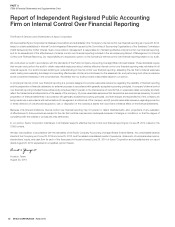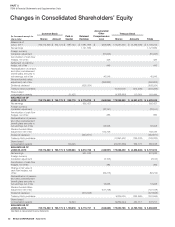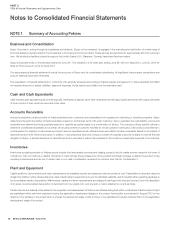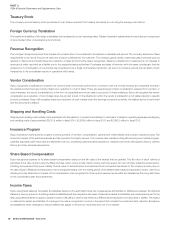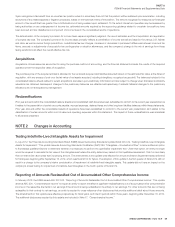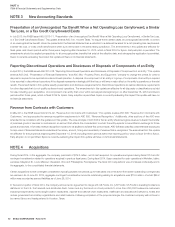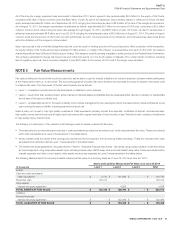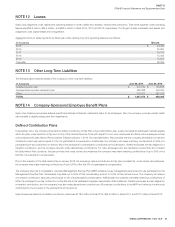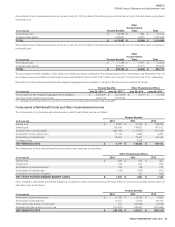Sysco 2014 Annual Report Download - page 72
Download and view the complete annual report
Please find page 72 of the 2014 Sysco annual report below. You can navigate through the pages in the report by either clicking on the pages listed below, or by using the keyword search tool below to find specific information within the annual report.
SYSCO CORPORATION-Form10-K60
PARTII
ITEM8Financial Statements and Supplementary Data
NOTE3 New Accounting Standards
Presentation of an Unrecognized Tax Bene t When a Net Operating Loss Carryforward, a Similar
Tax Loss, or a Tax Credit Carryforward Exists
In July 2013, the FASB issued ASU 2013-11, “Presentation of an Unrecognized Tax Bene t When a Net Operating Loss Carryforward, a Similar Tax Loss,
or a Tax Credit Carryforward Exists.” This update amends ASC 740, “Income Taxes,” to require that in certain cases, an unrecognized tax bene t, or portion
of an unrecognized tax bene t, should be presented in the nancial statements as a reduction to a deferred tax asset for a net operating loss carryforward,
a similar tax loss, or a tax credit carryforward when such items exist in the same taxing jurisdiction. The amendments in this update are effective for
scal years, and interim periods within those years, beginning after December 15, 2013, which is scal 2015 for Sysco. Early adoption is permitted. The
amendments should be applied prospectively to all unrecognized tax bene ts that exist at the effective date, and retrospective application is permitted.
Sysco is currently evaluating the impact this update will have on its nancial statements.
Reporting Discontinued Operations and Disclosures of Disposals of Components of an Entity
In April 2014, the FASB issued ASU 2014-08, “Reporting Discontinued Operations and Disclosures of Disposals of Components of an Entity.” This update
amends ASC 205, “Presentation of Financial Statements,” and ASC 360, “Property, Plant, and Equipment,” primarily to change the criteria for when a
disposal is required to be reported as a discontinued operation. A disposal of a component of an entity or a group of components of an entity is required
to be reported in discontinued operations if the disposal represents a strategic shift that has or will have a major effect on the entity’s operations or nancial
results. The amendments in this update specify presentation and disclosure requirements for discontinued operations as well as disclosure requirements
for other disposals that do not qualify as discontinued operations. The amendments in this update are effective for all disposals or classi cations as held
for sale, including upon acquisition, of a component of an entity that occur within annual periods beginning on or after December 15, 2014 and interim
periods within those years, which is scal 2016 for Sysco. Early adoption is permitted. Sysco is currently evaluating the impact this update will have on
its nancial statements.
Revenue from Contracts with Customers
In May 2014, the FASB issued ASU 2014-09, “Revenue from Contracts with Customers.” This update creates ASC 606, “Revenue from Contracts with
Customers,” and supercedes the revenue recognition requirements in ASC 605, “Revenue Recognition.” Additionally, other sections of the ASC were
amended to be consistent with the guidance in this update. The core principle of ASC 606 is that an entity should recognize revenue to depict the transfer
of promised goods or services to customers in an amount that re ects the consideration to which the entity expects to be entitled in exchange for those
goods and services. A ve-step revenue recognition model is to be applied to achieve this core principle. ASC 606 also speci es comprehensive disclosures
to help users of nancial statements understand the nature, amount, timing and uncertainty of revenue that is recognized. The amendments in this update
are effective for annual periods beginning after December 15, 2016, including interim periods within that reporting period, which is scal 2018 for Sysco.
Early adoption is not permitted. Sysco is currently evaluating the impact this update will have on its nancial statements.
NOTE4 Acquisitions
During scal 2014, in the aggregate, the company paid cash of $79.3 million, net of cash acquired, for operations acquired during scal 2014 and for
contingent consideration related to operations acquired in previous scal years. During scal 2014, Sysco acquired for cash operations in Meridian, Idaho;
Landover, Maryland; St. Louis, Missouri; Cleveland, Ohio and Philadelphia, Pennsylvania. The scal 2014 acquisitions were immaterial, individually and in
the aggregate, to the consolidated nancial statements.
Certain acquisitions involve contingent consideration typically payable over periods up to three years only in the event that certain outstanding contingencies
are resolved. As of June 28, 2014, aggregate contingent consideration amounts outstanding relating to acquisitions was $70.6 million, of which $55.2
million was recorded as earnout liabilities as of June 28, 2014.
In the second quarter of scal 2014, the company announced an agreement to merge with US Foods, Inc. (US Foods). US Foods is a leading foodservice
distributor in the U.S. that markets and distributes fresh, frozen and dry food and non-food products to more than 200,000 foodservice customers
including independently owned single location restaurants, regional and national chain restaurants, healthcare and educational institutions, hotels and
motels, government and military organizations and retail locations. Following completion of the proposed merger, the combined company will continue to
be named Sysco and headquartered in Houston, Texas.


